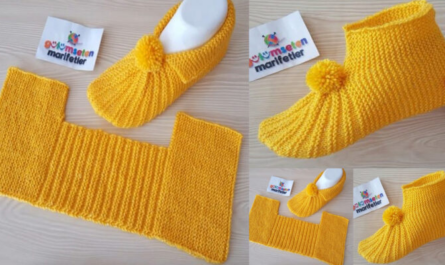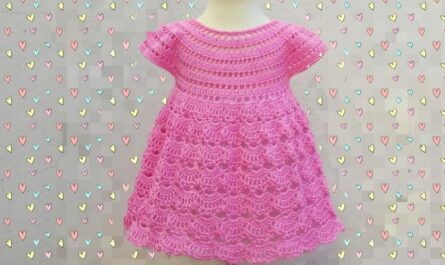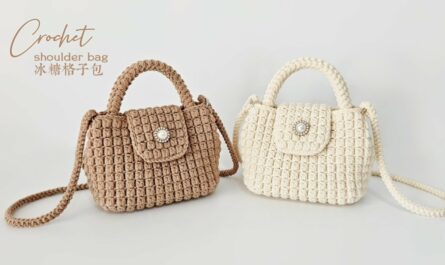The crisp air of spring, the promise of warmth, and the delicate beauty of a garden awakening – these are the inspirations behind the “Early Bloom” crochet cardigan or coat for girls. More than just a garment, this piece is a wearable ode to the season, blending comfort and style with the charming touch of handmade artistry.
Whether you envision a lightweight cardigan for breezy days or a cozy coat for cooler spring mornings, the “Early Bloom” concept allows for beautiful personalization, integrating textures and motifs that evoke budding flowers and fresh greenery. This detailed guide will walk you through the journey of crocheting such a special piece, from yarn selection to the final flourishing details.
What is the “Early Bloom” Cardigan/Coat?
The “Early Bloom” cardigan/coat is characterized by its:
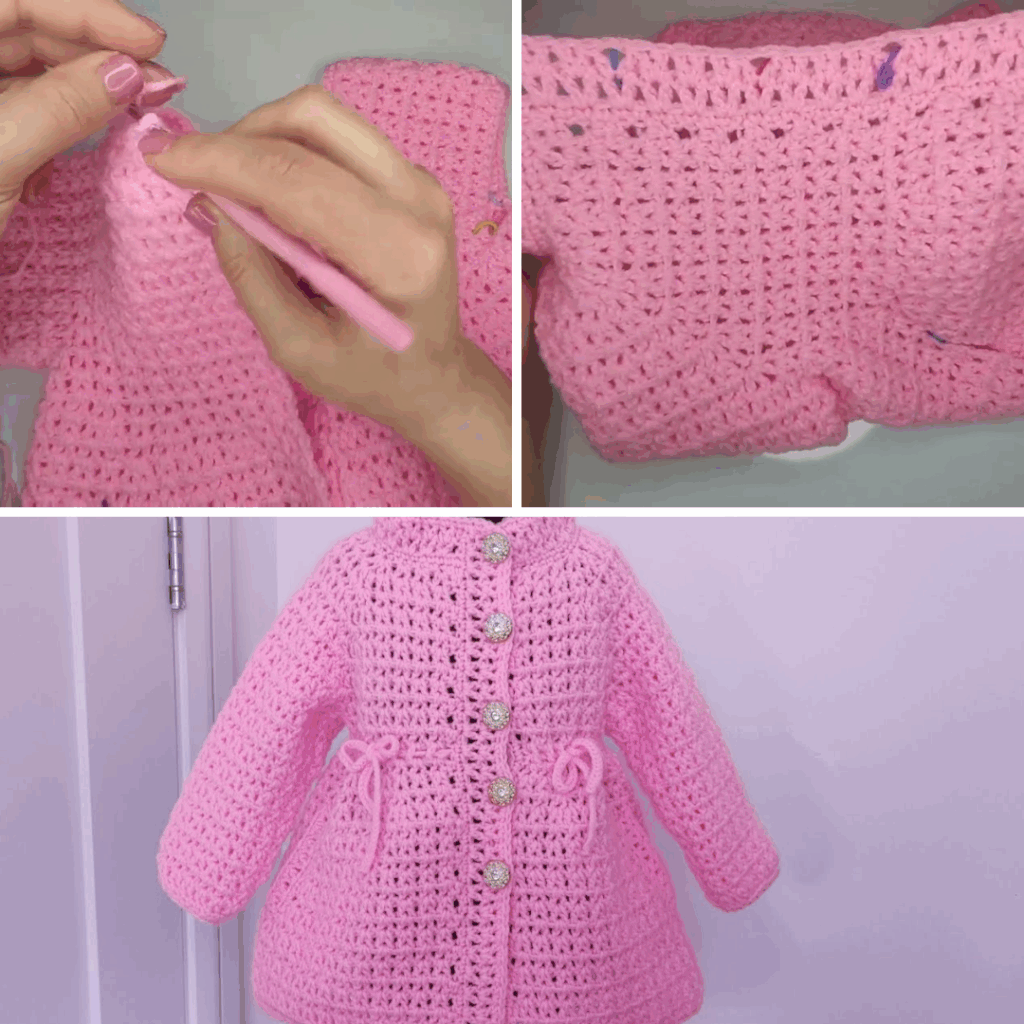
- Spring-Inspired Aesthetic: Think soft pastels, gentle greens, creamy whites, or subtle variegated yarns that mimic nature’s palette.
- Textural Details: Often incorporates stitches that resemble buds, petals, or leaves, such as puff stitches, bobbles, cluster stitches, or simple worked-in floral motifs.
- Comfort & Practicality: Designed for active girls, ensuring a comfortable fit, ease of movement, and appropriate warmth for transitional weather.
- Versatile Style: Can range from a lighter cardigan with delicate openwork to a denser coat with more structured elements, depending on yarn choice and stitch pattern.
Why Crochet This Cardigan/Coat?
- Personalized Masterpiece: Choose specific colors and add unique floral touches that resonate with your vision or the recipient’s personality.
- Heirloom Quality: A handmade coat imbued with love becomes a cherished item, possibly passed down through generations.
- Perfect for Transitional Weather: Provides just the right amount of warmth for spring or early autumn, layering beautifully over dresses or tops.
- Skill Enhancement: A garment project offers a fantastic opportunity to master shaping techniques, working with multiple pieces (or top-down construction), and integrating decorative elements.
- Thoughtful Gift: Nothing says “I care” quite like a custom, handmade garment.
Choosing Your Tools & Materials:
The right supplies are crucial for bringing your “Early Bloom” vision to life.
- Yarn: The Foundation of Your Bloom
- Fiber:
- Superwash Merino Wool: Excellent for a warm yet breathable coat. It’s incredibly soft, drapes beautifully, and is machine washable (crucial for kids’ clothes!).
- Acrylic Blends (e.g., Acrylic/Nylon, Acrylic/Wool): A great durable, affordable, and easy-care option. Modern acrylics are very soft and come in a vast array of colors. Good for a sturdy coat.
- Cotton Blends (e.g., Cotton/Acrylic, Cotton/Bamboo): Ideal for a lighter cardigan or if you live in a warmer climate. Cotton offers breathability and stitch definition. Bamboo blends add drape and softness.
- Avoid: Heavy, scratchy wools unless specifically treated for softness, or purely synthetic “fun” yarns that lack warmth or drape.
- Weight:
- DK (Double Knitting / Category 3): Most versatile. Creates a lovely fabric that’s light enough for a cardigan but can be dense enough for a coat with a slightly smaller hook.
- Worsted (Aran / Category 4): Ideal for a warmer, more substantial coat. Will work up faster but result in a thicker fabric.
- Color Palette (“Early Bloom” Specific):
- Main Color: Soft pastels (cream, pale grey, dusty rose, sky blue, sage green, lavender), or classic neutrals (oatmeal, white).
- Accent Colors (for “Blooms”): Small amounts of brighter shades like daffodil yellow, fuchsia, lilac, or a deeper green for leaves. Variegated yarns that blend spring colors can also be stunning.
- Quantity: Varies widely by size and yarn weight. For a toddler (2T-4T), expect 600-1000 yards; for older girls (6Y-10Y), 1000-1800+ yards. Always check your chosen pattern’s recommendations.
- Fiber:
- Crochet Hook:
- Consult your chosen yarn label for a suggested hook size.
- Crucial for Garments: Your actual hook size will be determined by achieving the correct gauge for your pattern. You’ll likely need to go up or down by half a size from the label’s suggestion.
- Other Notions:
- Stitch Markers: Essential for marking raglan lines, the beginning of rounds, or specific shaping points.
- Tapestry Needle: For neatly weaving in all yarn ends and sewing any applique details.
- Scissors.
- Buttons: 3-6 (or more for a longer coat) small to medium-sized buttons that complement your chosen colors. Opt for flat buttons for comfort.
- Sewing Needle & Thread: To securely attach buttons.
- Blocking Mats & T-Pins: (Highly recommended) For shaping and finishing your garment.
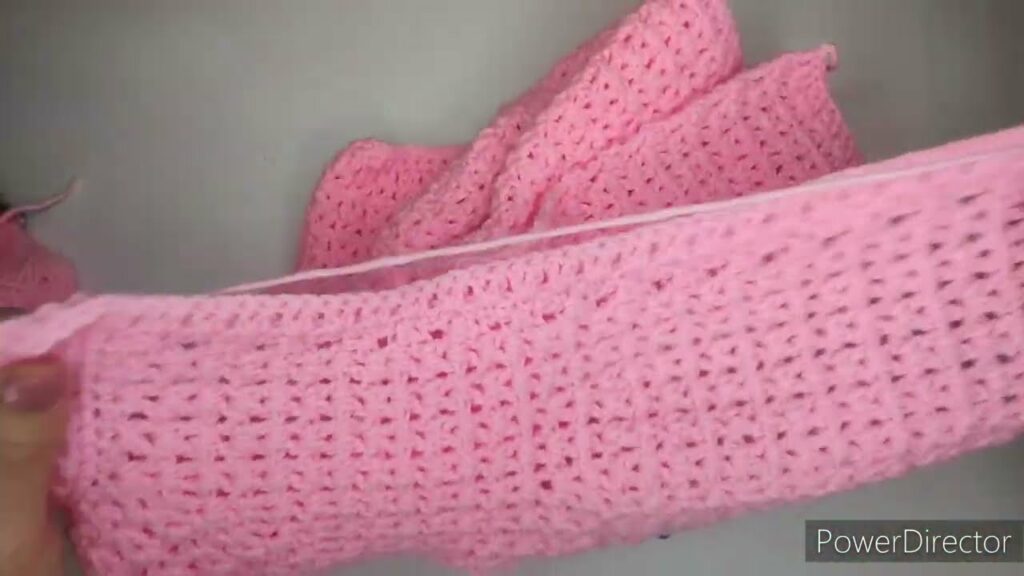
Understanding Sizing & Gauge (ABSOLUTELY CRITICAL for Garments!)
Accurate sizing is the cornerstone of a well-fitting and comfortable garment. Crocheting garments without checking gauge is the most common reason for projects not fitting.
General Girls’ Sizing (Approximate Measurements):
| Size | Approx. Chest Circ. | Approx. Finished Body Length (Shoulder to Hem) | Approx. Sleeve Length (Underarm to Cuff) |
|---|---|---|---|
| 2T | 21 inches | 14-16 inches | 9-10 inches |
| 4T | 23 inches | 16-18 inches | 10-11 inches |
| 6Y | 25 inches | 18-20 inches | 11-12 inches |
| 8Y | 27 inches | 20-22 inches | 12-14 inches |
| 10Y | 28 inches | 22-24 inches | 14-16 inches |
Export to Sheets
video tutorial part 1;
Disclaimer: These are general averages. Always refer to the specific pattern’s measurements and sizing chart.
How to Make a Gauge Swatch (Do NOT Skip This Step!):
- Chain: Chain about 25-30 stitches, plus any turning chains (e.g., ch 3 for dc) as per your chosen main stitch pattern.
- Work: Crochet a square of at least 6×6 inches (15×15 cm) in the main stitch pattern you’ll be using for the coat. A larger swatch provides a more accurate measurement.
- Wash & Block: Fasten off your swatch. Crucially, wash and block your swatch exactly as you plan to treat the finished garment. This step relaxes the fibers and reveals the true stitch size and drape after washing, which can change significantly.
- Measure: Once dry, lay the swatch flat. Place a ruler over the center. Count how many stitches fit within 4 inches (10 cm) and how many rows fit within 4 inches (10 cm).
- Adjust:
- If you have more stitches per inch than your pattern (or desired gauge) states (your work is too tight), go up half a hook size and re-swatch.
- If you have fewer stitches per inch than your pattern states (your work is too loose), go down half a hook size and re-swatch.
- Repeat until your gauge precisely matches.
General Stitch Patterns for “Early Bloom”:
- Main Body (for warmth and structure):
- Half Double Crochet (hdc): Creates a dense, warm fabric with good drape.
- Double Crochet (dc): Works up quickly, creates a softer drape, suitable for a lighter coat/cardigan.
- Moss Stitch (Linen Stitch): (sc, ch 1, sk 1) Creates a beautiful, dense, textured fabric with good drape, very appropriate for a coat.
- Extended Single Crochet (esc) or Extended Half Double Crochet (ehdc): Creates a slightly taller, looser stitch than standard sc/hdc, offering good drape without being too open.
- “Early Bloom” Accents & Texture:
- Puff Stitch / Bobble Stitch / Cluster Stitch: Perfect for creating “buds” or small textural “flowers” directly worked into the fabric.
- Shell Stitch / Fan Stitch: (e.g., 5 dc in one stitch) Can be used for delicate ruffles on the hem, cuffs, or collar, mimicking petals.
- V-Stitch: (dc, ch 1, dc) Creates a delicate openwork that can be integrated as a subtle lace element.
- Crochet Flowers & Leaves (Applique): Small, separate motifs crocheted and then sewn onto the finished garment.
- Ribbing (for cuffs and hem):
- Front Post/Back Post Double Crochet (fpdc/bpdc): Creates a strong, elastic ribbed edge.
- Single Crochet in Back Loop Only (sc blo): Creates a simpler, stretchier ribbing.
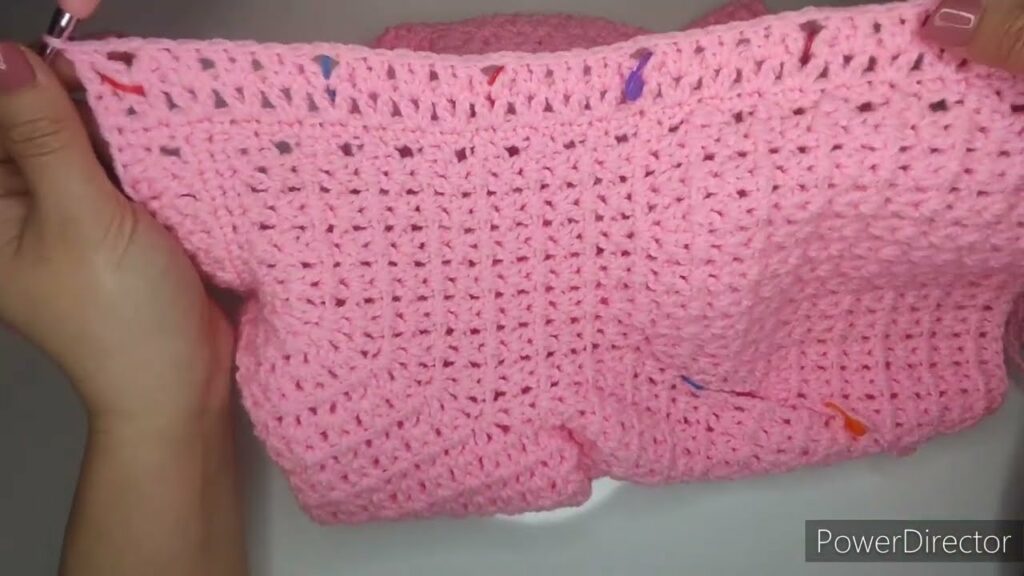
Step-by-Step Construction: The “Early Bloom” Cardigan/Coat (Top-Down Preferred)
This outline describes a common and highly favored construction method for children’s garments due to minimal seaming. This is a general guide to the methodology; for precise stitch counts, specific increase/decrease rates for different sizes, and unique design details, you MUST use a detailed crochet pattern.
Phase 1: The Yoke (Top-Down, Raglan Shaping)
This forms the neckline, shoulders, and upper chest, worked in rows from the top down.
- Step 1.1: Starting Chain & Neckband
- Foundation Chain: Chain the number of stitches specified by your pattern for the neckline circumference.
- Neckband Rows: Ch 1 (or ch 2/3 for taller stitches). Work 2-4 rows in sc or hdc (or a soft ribbing like sc blo) for a stable and neat neckband.
- Button Band/Buttonholes: On one side of the back opening (usually the wearer’s right side, or as per pattern), establish your button band. Create small, evenly spaced buttonholes on designated rows (e.g., ch 2, skip 2 stitches, then work into the ch-2 space on the next row).
- Step 1.2: Setting Up Raglan Yoke Divisions
- First Yoke Row (Raglan Setup): This row divides your total stitches into: Back Panel 1, Sleeve 1, Front Panel, Sleeve 2, and Back Panel 2. You will have 4 raglan corners where all shaping increases occur.
- Work your main stitch (e.g., dc) for Back Panel 1. At the first raglan corner, work your increase (e.g., [dc, ch 2, dc] or [2 dc, ch 1, 2 dc]). Place a stitch marker (SM) in the ch-2 or ch-1 space. Continue this pattern for all 4 corners. Turn.
- First Yoke Row (Raglan Setup): This row divides your total stitches into: Back Panel 1, Sleeve 1, Front Panel, Sleeve 2, and Back Panel 2. You will have 4 raglan corners where all shaping increases occur.
- Step 1.3: Continuing Yoke Increases
- Subsequent Yoke Rows: Continue working your main stitch across, and work your specified increase into each of the 4 raglan spaces from the previous row. Move your stitch markers up to the new increase spaces. Turn.
- Continue working these increase rows until the yoke measures the correct depth from the top of the neckline to the underarm for your chosen size. Ensure you continue adding buttonholes on your button band at regular intervals.
Phase 2: Separating for Body & Sleeves
Once the yoke is the correct depth, you’ll divide the stitches to create the armholes.
- Separation Row:
- Work stitches for Back Panel 1.
- Work into Raglan Corner 1.
- Skip Sleeve 1: Place all stitches of Sleeve 1 (the stitches between Raglan Corner 1 and Raglan Corner 2) onto a piece of scrap yarn or a stitch holder.
- Underarm Chain: Chain 2-4 stitches (this creates extra room at the underarm and fills the gap).
- Work into Raglan Corner 2.
- Work stitches for the Front Panel.
- Work into Raglan Corner 3.
- Skip Sleeve 2: Place all stitches of Sleeve 2 onto a holder.
- Underarm Chain: Chain 2-4 stitches.
- Work into Raglan Corner 4.
- Work stitches for Back Panel 2. Turn.
Phase 3: The Body (Torso) of the Cardigan/Coat
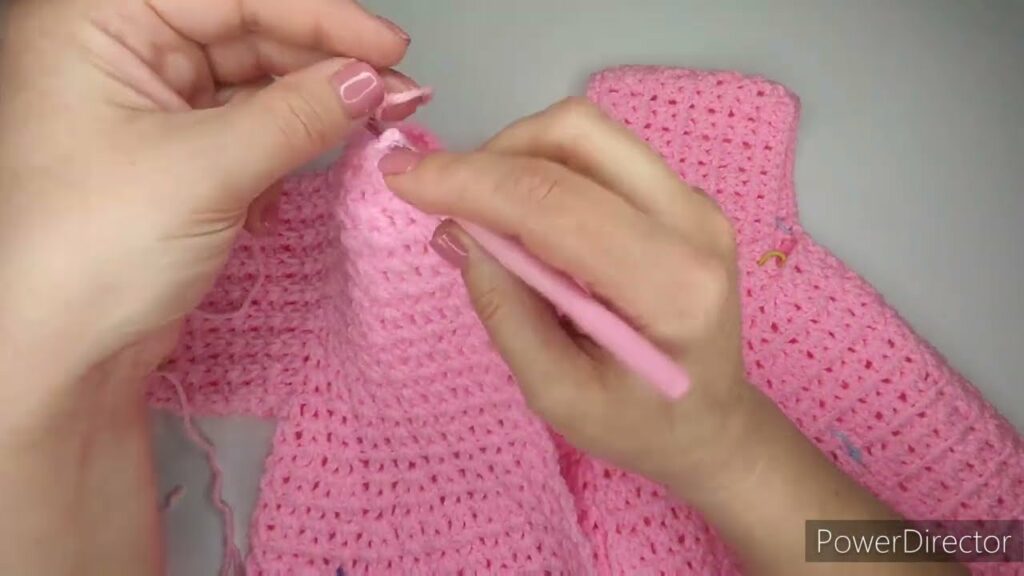
This forms the main body of the garment below the armholes.
- First Body Row: Continue working flat across the back panels, front panel, and the underarm chains. This continues the back opening for the button band.
- Continuing Body Rows: Continue working in rows using your chosen main stitch (or a texture stitch like moss stitch).
- Shaping: Maintain the width of the body, or add very slight increases/decreases as specified by your pattern for a gentle A-line shape.
- Length: Continue working until the body reaches the desired length from the underarm to the hem for your chosen size.
- Hem/Bottom Ribbing: Finish the body with a few rows of ribbing (e.g., fpdc/bpdc or sc blo) for a neat and slightly elastic edge.
Phase 4: The Sleeves (Make 2)
Each sleeve is typically worked in the round from the armhole down to the cuff.
- Attach Yarn: Attach your yarn to the center underside of one armhole opening (where your underarm chain was).
- Pick Up Stitches: Work a round of your main stitch, picking up stitches evenly around the armhole opening (including into the underarm chain stitches). Join with a sl st to the first stitch to form a round.
- Working the Sleeve: Continue working in rounds using your main stitch pattern.
- Shaping: Gradually decrease stitches evenly spaced over several rounds to taper the sleeve towards the wrist (check your pattern for specific decrease rates).
- Length: Work until the sleeve reaches the desired length from the underarm to the wrist.
- Cuff Ribbing: Finish the sleeve with a few rows of ribbing (fpdc/bpdc or sc blo) for a comfortable and snug cuff.
- Fasten off. Repeat for the second sleeve, ensuring it is symmetrical to the first.
Phase 5: The “Early Bloom” Details (Adding the Special Touches)
This is where your cardigan/coat truly blossoms!
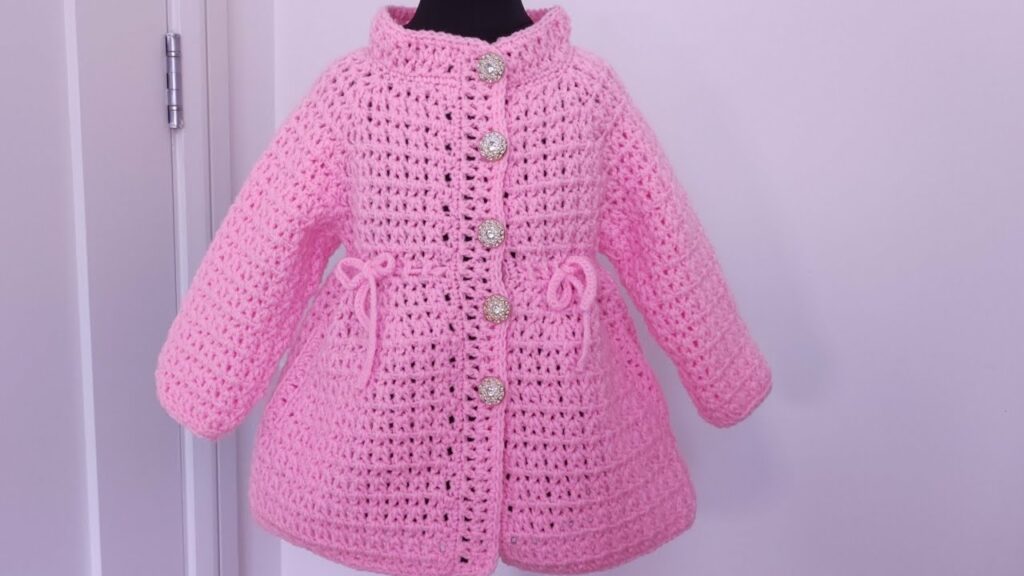
- Worked-In Textures: If your pattern includes them, ensure your puff stitches, bobbles, or cluster stitches are integrated as specified in the yoke, body, or sleeves.
- Applique Flowers & Leaves:
- Crochet: Crochet small, individual flowers (simple 5-petal designs, layered flowers) and leaves in your accent colors.
- Placement: Strategically place these appliques. Consider clusters around the neckline, trailing down the front opening, scattered across the yoke, or blooming on the cuffs.
- Attachment: Use your tapestry needle and matching yarn to securely sew each applique onto the coat. Weave all tails from the appliques into the back of the coat fabric.
- Ruffles/Edging: If desired, add a delicate ruffle (e.g., using Shell Stitch) around the neckline, collar, or hem of the coat for an extra “bloom” touch.
- Collar (Optional): If your design includes a collar, crochet it separately (often in rows) and then securely sew it to the neckline.
Phase 6: Finishing Touches
These final steps bring your garment to a professional and durable completion.
- Weave in All Ends: Using your tapestry needle, meticulously weave in every single yarn tail. Secure them firmly by weaving them into existing stitches in different directions. This is crucial for a neat, durable, and safe finish (no loose ends for little fingers).
- Attach Buttons: Sew your chosen buttons securely to the button band, aligning them precisely with the buttonholes you created. Double-check that they are very firmly attached, as buttons can be a safety concern for children if loose.
- Blocking (ABSOLUTELY CRUCIAL for Garments!):
- Gentle Wash: Fill a basin with cool water and a small amount of mild, wool-friendly detergent (even for acrylic blends). Gently submerge the coat and let it soak for 20-30 minutes. Do not agitate vigorously.
- Rinse: Gently squeeze out the soapy water (do not wring or twist). Rinse under cool, running water until all soap is gone.
- Remove Excess Water: Gently roll the coat in a clean, dry towel and press firmly to absorb as much water as possible.
- Shape & Dry: Lay the coat flat on blocking mats. Gently stretch and shape it to the correct finished dimensions (chest, length, sleeve length) for your chosen size. Smooth out any unevenness, open up texture stitches, and define the edges. Use rust-proof T-pins to hold the shape firmly.
- Air Dry Completely: Allow the coat to air dry completely. Blocking truly transforms the fabric, softening it, evening out your stitches, enhancing the drape, and giving your “Early Bloom” cardigan/coat a beautifully polished, professional appearance.
Tips for “Early Bloom” Cardigan/Coat Success:
- Yarn Quality is Paramount: Choose soft, comfortable fibers suitable for a child’s delicate skin.
- Gauge Consistency: It’s the most important factor for achieving the correct size and fit.
- Safety First: Ensure all buttons are securely sewn. Avoid any small, detachable embellishments that could pose a choking hazard.
- Try It On (If Possible): If you have access to the child (or a similar-sized garment), compare your work as you go to ensure a good fit.
- Don’t Rush Finishing: Weaving in ends and blocking might seem tedious, but they are essential for a beautiful and long-lasting garment.
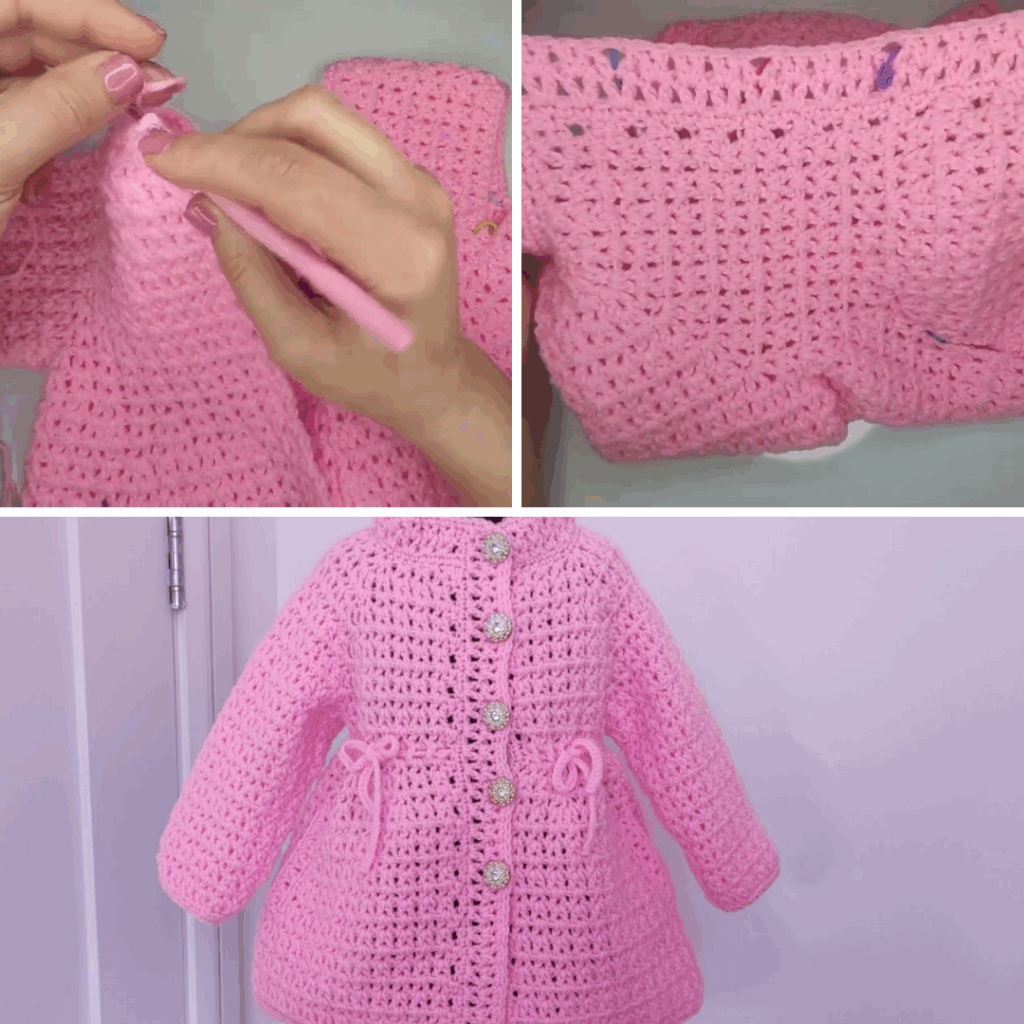
Care Instructions for Your Handmade Coat:
- Always follow your yarn label’s specific care instructions. This will dictate whether it’s hand wash only, machine wash gentle, or machine dry.
- Reshape and Lay Flat to Dry: Always gently reshape the coat while wet and lay it flat on a clean towel or drying rack to air dry completely. Do not hang, as this can stretch the fabric and distort the garment’s shape.
video tutorial part 2;
Creating an “Early Bloom” cardigan or coat is a truly rewarding experience. With every stitch, you’re infusing warmth, creativity, and love into a garment that will wrap a special girl in comfort and charming style, just like the gentle embrace of spring. Happy hooking!

